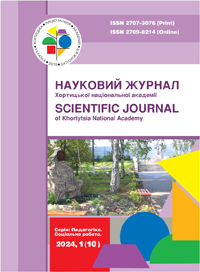УДК 376 ОРГАНІЗАЦІЯ ПРОЦЕСУ ВИКОРИСТАННЯ ІНТЕРАКТИВНОЇ ВІРТУАЛЬНОЇ ДОШКИ В ОСВІТНЬОМУ ПРОСТОРІ ЗАКЛАДУ ВИЩОЇ ОСВІТИ
DOI : https://doi.org/10.51706/2707-3076-2023-10-6
Анотація
Методична розвідка презентує авторський проєкт впровадження в освітній процес закладу вищої освіти нового навчального інструменту – віртуальної дошки. Дослідження проходило в кілька етапів, а саме: 1 – виокремлено чіткі завдання та цілі, для максимізації ефективності подальшої розбудови проєкту; 2 – проаналізовано та розроблено карту ресурсів, що будуть необхідні на етапі втілення проєкту в життя; 3 – розбудовано чіткий календарний графік з розрахунком конкретних часових проміжків для кожного з етапів проєкту; 4 – велику увагу приділено проблемним питанням, які безумовно можуть зустрітися на шляху реалізації завдань; 5 – запропоновані ефективні методи тестування та оцінки ефективності проєкту «Використання інтерактивної віртуальної дошки в освітньому просторі».




 Комунальний заклад вищої освіти «Хортицька національна навчально-реабілітаційна академія» Запорізької обласної ради є закладом вищої освіти, що провадить інноваційну освітню діяльність, пов’язану з наданням вищої освіти за кількома галузями знань, проводить фундаментальні та прикладні наукові дослідження, є провідним науковим і методичним осередком, має розвинуту інфраструктуру навчальних, наукових і науково-виробничих підрозділів, сприяє поширенню наукових знань та проводить культурно-просвітницьку діяльність.
Комунальний заклад вищої освіти «Хортицька національна навчально-реабілітаційна академія» Запорізької обласної ради є закладом вищої освіти, що провадить інноваційну освітню діяльність, пов’язану з наданням вищої освіти за кількома галузями знань, проводить фундаментальні та прикладні наукові дослідження, є провідним науковим і методичним осередком, має розвинуту інфраструктуру навчальних, наукових і науково-виробничих підрозділів, сприяє поширенню наукових знань та проводить культурно-просвітницьку діяльність.